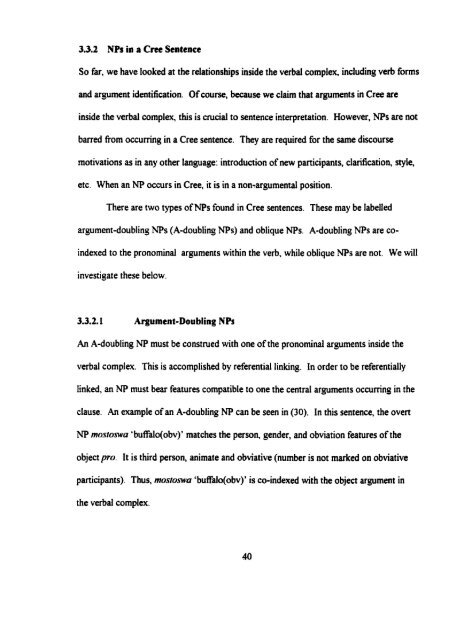Adverbial and Argument-Doubling Clauses in Cree - MSpace
Adverbial and Argument-Doubling Clauses in Cree - MSpace
Adverbial and Argument-Doubling Clauses in Cree - MSpace
You also want an ePaper? Increase the reach of your titles
YUMPU automatically turns print PDFs into web optimized ePapers that Google loves.
3.3.2 NPs <strong>in</strong> a <strong>Cree</strong> Sentence<br />
So far, we have looked at the relationships <strong>in</strong>side the verbal complex, <strong>in</strong>clud<strong>in</strong>g verb forms<br />
<strong>and</strong> argument identification. Of course, because we daim that arguments <strong>in</strong> <strong>Cree</strong> are<br />
<strong>in</strong>side the verbal complex, this is crucial to sentence <strong>in</strong>terpretation. However, NPs are not<br />
barred fiom occumng <strong>in</strong> a <strong>Cree</strong> sentence. They are required for the same discourse<br />
motivations as <strong>in</strong> any other language: <strong>in</strong>troduction of new participants, clarification, style,<br />
etc. When an NP occurs <strong>in</strong> <strong>Cree</strong>, it is <strong>in</strong> a non-argumental position.<br />
There are two types of NPs found <strong>in</strong> <strong>Cree</strong> sentences. These may be labelled<br />
argument-doubl<strong>in</strong>g NPs (A-doubl<strong>in</strong>g NPs) <strong>and</strong> oblique NPs. A-doubl<strong>in</strong>g NPs are co<strong>in</strong>dexed<br />
to the pronom<strong>in</strong>al arguments with<strong>in</strong> the verb, while oblique NPs are not. We will<br />
<strong>in</strong>vestigate these below.<br />
3.3.2.1 <strong>Argument</strong>-Dou bl<strong>in</strong>g NPs<br />
An A-doubl<strong>in</strong>g NP mut be construed with one of the pronom<strong>in</strong>al arguments <strong>in</strong>side the<br />
verbal complex. This is accomplished by referential l<strong>in</strong>k<strong>in</strong>g. In order to be referentially<br />
l<strong>in</strong>ked, an NP must bear features compatible to one the central arguments occumng <strong>in</strong> the<br />
clause. An example of an A-doubl<strong>in</strong>g NP can be seen <strong>in</strong> (30). In this sentence, the overt<br />
hT mostoswa 'buffalo(obv)' matches the person, gender, <strong>and</strong> obviation features of the<br />
object pro. It is third person, animate <strong>and</strong> obviative (number is not marked on obviative<br />
participants). Thus, moszswa 'buffalo(obv)' is co-<strong>in</strong>dexed with the object argument <strong>in</strong><br />
the verbal complex.








![an unusual bacterial isolate from in partial fulf]lment for the ... - MSpace](https://img.yumpu.com/21942008/1/190x245/an-unusual-bacterial-isolate-from-in-partial-fulflment-for-the-mspace.jpg?quality=85)




![in partial fulfil]ment of the - MSpace - University of Manitoba](https://img.yumpu.com/21941988/1/190x245/in-partial-fulfilment-of-the-mspace-university-of-manitoba.jpg?quality=85)


